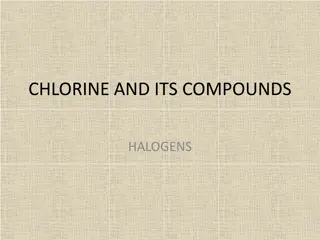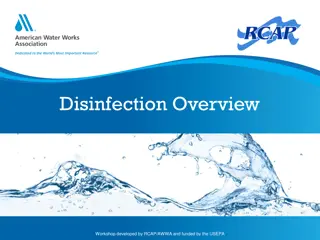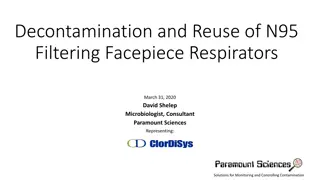Complying with Chlorine Gas Regulations
Explore the compliance and reporting requirements related to handling chlorine gas in water treatment facilities. Learn about the regulations set by organizations like IEMA, EPA, and OSHA, emphasizing safety measures, reporting thresholds, and emergency planning in response to hazardous substances.
0 views • 32 slides
Guidelines for General Cleaning and Prohibitions in Zamboanga City
The document outlines regulations for general cleaning on Sundays in Zamboanga City, with specific disinfection protocols using bleach and chlorine. It also prohibits social gatherings and non-essential entry of people to and from the Enhanced Community Quarantine zone, except for essential workers
1 views • 13 slides
Understanding Ozone Depletion: Causes and Impact
The ozone layer, found in the stratosphere at 15 to 40 km altitude, plays a crucial role in absorbing harmful ultraviolet radiation. However, due to the use of Chlorofluorocarbons (CFCs), the ozone layer has been depleted, leading to the formation of the ozone hole. This depletion is caused by chemi
0 views • 27 slides
Chemical Reactions and Separation Techniques in Chemistry
This presentation covers various chemical reactions and separation techniques in chemistry, including electron configuration, precipitation reactions, chlorine reactions with sodium hydroxide, and apparatus used to separate immiscible liquid layers. Explore topics such as electron configurations of
0 views • 28 slides
Essential Guidelines for Chlorine Disinfection in Water Treatment
Learn about the usage and key points to watch for when implementing chlorine disinfection in water treatment processes. Understand the effectiveness, dosing methods, safety considerations, and monitoring protocols to ensure successful water disinfection. Proper handling of hypochlorite solution, mon
1 views • 7 slides
Overview of Alkaloids: Classification, Sources, and Characteristics
Alkaloids are organic nitrogenous compounds found in plants with physiological activity. They may also contain elements like oxygen, sulfur, chlorine, and phosphorus. Alkaloids can be sourced from plants, animals, bacteria, fungi, or industrial synthesis. Their names can be derived from plant names,
0 views • 19 slides
Chlorine and Halogens: Properties, Reactions, and Industrial Uses
Halogens, including chlorine, are in group 7 of the periodic table and have 7 electrons in their outer shell. They easily form negative ions by gaining an electron. Chlorine is symbolized as Cl and has two isotopes, 37Cl and 35Cl, with an electronic arrangement of 2:8:7. It can be prepared in the la
4 views • 31 slides
Antarctic Ozone Hole Recovery and Future Challenges
Depletion of the stratospheric ozone layer in Antarctica due to chlorine emissions led to the formation of the ozone hole. Since the phasing out of Ozone-Depleting Substances (ODSs) under the Montreal Protocol, there has been a reduction in anthropogenic ODSs in the troposphere. Observations and che
0 views • 12 slides
Comprehensive Overview of Water Disinfection and Chlorination Basics
This workshop explores the importance and various methods of water disinfection, focusing on chlorination basics, chloramines, disinfection types, and the impacts of pH on chlorine disinfection. Learn about the necessity of disinfection in water systems, different disinfectants used, and the need fo
0 views • 37 slides
Kinneret College Water Industry Engineering Department Overview
Kinneret College, established in 1965, offers B.A. and B.Sc. degrees through its School of Engineering, with a focus on Water Industry Engineering. The department, led by Prof. Ram Shpiner, provides a balanced mix of practical and theoretical studies to prepare engineers for the evolving water indus
0 views • 9 slides
Essential Laundry Tips: Washing Instructions, Clothing Preparation & Bleach Safety
Understanding the importance of reading garment labels before laundering, proper clothing preparation tips, knowing which types of clothing to wash in hot, warm, or cold water, precautions for using chlorine bleach, benefits of powdered oxygen bleach, and why chlorine and ammonia should never be mix
0 views • 16 slides
Buckingham Park Water District Tracer Study by Guy Schott: Detailed Analysis
Detailed analysis and findings from a tracer study conducted on 2/10/16 at Buckingham Park Water District by Guy Schott. The study includes information on the 200K Clearwell, outlet configurations, baffle heights, nozzle velocities, chlorine residual levels, and more. Insights on flow rates, dosage,
0 views • 13 slides
Pool Regulation Changes for 2018 - Important Updates for Pool Maintenance
In 2018, David Hornsby, REHS Area Manager, introduced significant changes in pool regulation. These changes include updated minimum disinfectant levels, specific requirements for different pool types such as spas, interactive water play pools, activity pools, wading pools, and more. Additionally, ma
0 views • 31 slides
Woodland Public Schools Facilities and Safety Report April 2022
Woodland Public Schools provided an update on facility improvements and safety measures in their April 2022 report. Highlights include the installation of a new chlorine analyzer at Yale Elementary, delivery of a HAAS VF2 vertical milling machine for the AJAC program at WMS, LED sign installations,
0 views • 6 slides
Polymeric LED Synthesis Routes and Precursor Methods Explained
Explore the synthesis routes and precursor methods for polymeric LEDs, including the Wessling method, precursor routes to PPV, and the sulfur and chlorine precursor routes. Learn about the role of soluble polymers, thermal treatments, and the effects of side groups in the synthesis process.
0 views • 21 slides
The Halogens: Properties and Uses of Fluorine, Chlorine, Bromine, Iodine, and Astatine
The halogens are a group of non-metals in the periodic table with seven electrons in their outer shell, making them highly reactive. This article discusses the properties and uses of fluorine, chlorine, bromine, iodine, and astatine. Fluorine is utilized in toothpaste, chlorine is commonly used as a
0 views • 13 slides
Group 17 Elements: The Halogens and Their Properties
Group 17 elements, known as the Halogens, include fluorine (F), chlorine (Cl), bromine (Br), iodine (I), and astatine (At). They exhibit unique properties such as small atomic radii, high ionization energy, and strong oxidizing power. The halogens form diatomic molecules and have varying electron co
0 views • 19 slides
Tracer Study Overview at Gualala CSD WWTP
A tracer study was conducted at the Gualala Community Services District Wastewater Treatment Plant to evaluate the modal contact time for the underground pipeline. The study included the installation of a second orifice pipeline jetting system to enhance mixing within the pipeline. Tracer material d
0 views • 15 slides
Understanding Group 17 Elements in Chemistry
Explore the properties, electron configurations, appearances, and industrial uses of Group 17 elements in the periodic table. Learn about nonmetals, metals, metalloids, and noble gases like fluorine, chlorine, bromine, iodine, and astatine. Discover the industrial production and reactions of hydroge
0 views • 20 slides
Understanding Disinfection Processes and Mechanisms
Disinfection is the process of partially destroying disease-causing organisms, different from sterilization where all organisms are destroyed. Various mechanisms of disinfectants include damaging cell walls, altering permeability, and inhibiting enzyme activity. Chemical and physical agents such as
0 views • 24 slides
Cosmogenic Chlorine-36 Chronology for Glacial Deposits at Bloody Canyon
Analyzing deposits from mountain glaciers using the cosmogenic chlorine-36 dating method in Bloody Canyon, Eastern Sierra Nevada. The study correlates the timing of glaciations with global ice volume peaks, showing agreement with marine oxygen isotope records. Boulder ages indicate rapid responses o
0 views • 4 slides
Understanding Bleach and Chlorine Compounds in Cleaning
Bleach and chlorine compounds are commonly used disinfectants with varying concentration ranges. They are effective at killing bacteria, fungi, and viruses, but require specific pH and concentration levels for optimal performance. Chlorine gas is particularly useful for sanitizing enclosed systems.
0 views • 8 slides
Uncovering Low-Hanging Fruit for Global Health Improvement
Delve into the underutilized preventive technologies that could save lives at a minimal cost. Explore why essential interventions like chlorine bleach, ORS, and improved water sources remain overlooked, contributing to health disparities and a cycle of poverty. Discover the potential of public healt
0 views • 14 slides
Overview of Cleaning Agents and Disinfectants in Healthcare Settings
Cleaning and disinfection play a crucial role in maintaining hygiene and preventing infections in healthcare settings. Cleaning involves the removal of foreign material from surfaces, while disinfection kills microorganisms. Hospital-grade disinfectants like alcohols, chlorine, phenolics, and hydrog
0 views • 13 slides
Decontamination and Reuse of N95 Filtering Facepiece Respirators
This presentation discusses the decontamination and reuse of N95 filtering facepiece respirators, addressing the need for solutions in sanitizing technologies like ultraviolet light and chlorine dioxide. Various methods under consideration, such as heat and hydrogen peroxide, are explored alongside
0 views • 16 slides
Textile Cleaning Solutions by Microgenix Specialities
X-Brite EWi and X-Brite from Microgenix Specialities are effective cleaning agents for soiled and stained textile materials. They enhance brightness on dyed fabrics and whiteness on white fabrics, while also removing residual dyestuff. Exclor OS is an all-purpose neutralizing agent that ensures comp
0 views • 20 slides

























